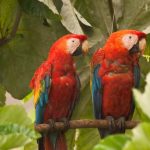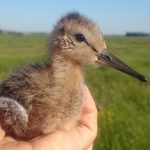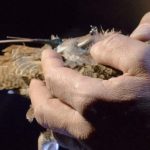← Back
Canola, a mixed blessing for Carnaby’s cockatoos?
![Male Carnaby’s cockatoo with back-mounted GPS tag. (from [Riley et al., 2023]). Argos PTT was attached to the ventral side of the two central tail feathers, and thus is not visible. Male Carnaby's cockatoo with back-mounted GPS tag. (from [Riley et al., 2023]). Argos PTT was attached to the ventral side of the two central tail feathers, and thus is not visible.](https://www.argos-system.org/wp-content/uploads/2024/02/Carnabys-cockatoos.jpg)
Carnaby’s cockatoos are endangered parrots, endemic to the south-west of Western Australia. They are beginning to feed on canola crops, which might be interesting for their survival – or not. Argos helps in trying to understands the importance and impact of this change in their foraging.
Carnaby’s cockatoos (Zanda latirostris) are parrots, endemic to the south-west of Western Australia. They are classified as endangered due to a decrease of the species probably in link with reduction of their natural habitat in favour of agriculture for the past century. They feed on seeds and plants – in the natural environment, Hakea and Banksia. However, recently, canola has been increasingly cultivated in their breeding range. While canola is more energetic than their usual diet, it is less proteinic, which might make it not fully adequate feeding for growing Carnaby’s cockatoo nestlings, even if breeding seems to increase.
Carnaby’s cockatoos tracked for foraging behaviours
Fourteen Carnaby’s cockatoos were equipped with telemetry trackers. Eight yielded data, the other six were destroyed by the birds before providing any. This is one of the challenges of tracking parrots: they often remove or destroy the tags (see also https://www.argos-system.org/track-macaw-movement-patterns). The cockatoos were each fitted with one high-resolution accelerometer-capable GPS tags to investigate foraging and one Argos satellite tag to locate them in order to observe them while foraging. They were all adults provisioning nestlings when equipped, which were at least 3 weeks old. Only the data collected during the period of nestling provisioning were analysed in this study.
More info about animal tracking with Argos
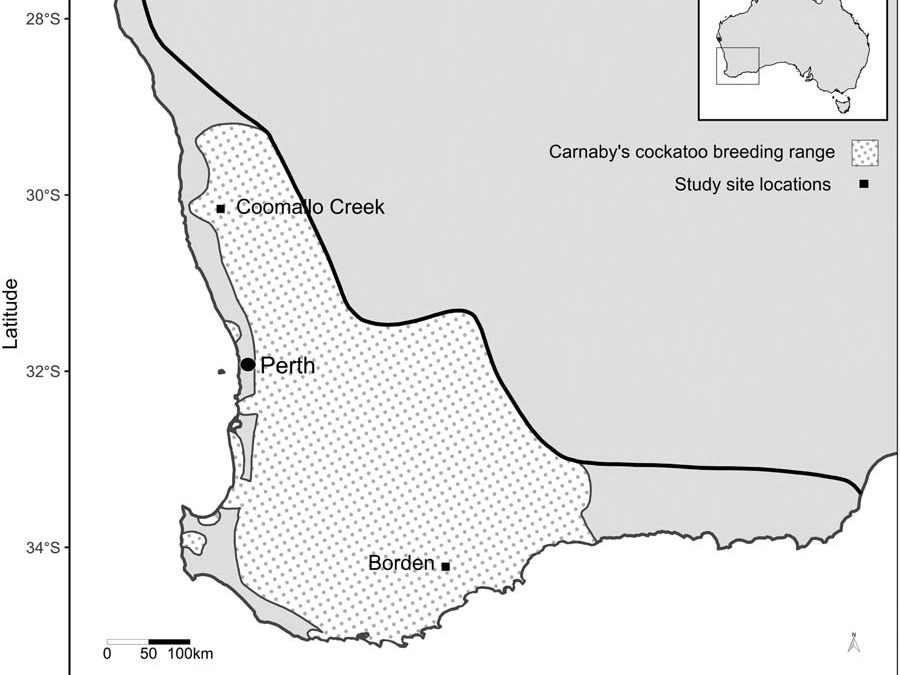
A behavioural classification, with either ‘resting’, ‘foraging’ or ‘flying’ behaviour, was assigned to each location using the accelerometer data. On-field observations were used to identify canola crop areas and the birds’ nesting hollows. Environmental data were also retrieved (e.g., daily maximum temperature, daylength).
A 750-m buffer around the nesting was used to remove behaviours observed close to the nest which may have been wrongly classified as foraging. The resources the Carnaby’s cockatoos fed from were identified using locations with the ‘foraging’ class occurring inside (foraging on canola) or outside (foraging on native vegetation) canola crop areas.
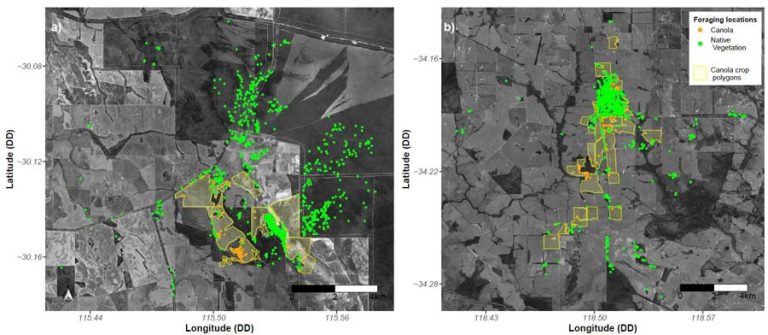
The foraging strategy required when utilising canola was less energy-intensive, with less accelerations observed, and shorter distances covered (average of 60% closer to nesting hollows). However, the Carnaby’s cockatoos only foraged on canola for 1h30 each day maximum, while their foraging time on native seeds could use as much as 2h30 (less when daily temperature was high). This might be a result of a recognition by foraging Carnaby’s cockatoo of the drawbacks of a steady diet of canola for their nestling, and a way of balancing the intake of high-energy canola with high-protein native seed.
This highlights that anthropogenic food sources can have not too adverse effects on wild animals, depending on their behaviour and on the maintained availability of their natural food. Conservation of Carnaby’s cockatoos, in particular, supposes that canola is not replacing much more native vegetation than currently the case in breeding areas. Greater dependence on canola will leave breeding populations more vulnerable to exposure to organophosphates and potential dietary deficiencies.
Reference & links
- Riley, K. J., Warren, K., Armstrong,N., Yeap, L., Dawson, R., Mawson, P. R., Saunders, D. A.,Cooper, C. E., & Shephard, J. M. (2023). Accelerometryreveals limits to use of an energy-saving anthropogenic foodsource by a threatened species: A case of Carnaby’scockatoos (Zanda latirostris) and canola. Ecology and Evolution, 13, e10598. https://doi.org/10.1002/ece3.10598

